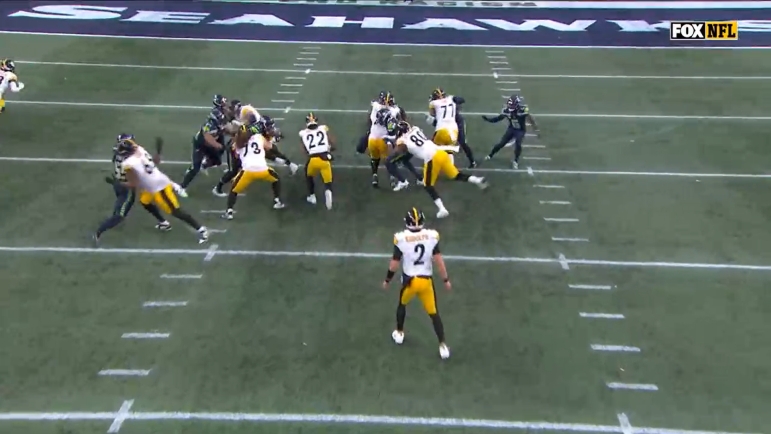One of the more common complaints after the Pittsburgh Steelers hired Arthur Smith as their new offensive coordinator was that he is so focused on the run game. After all, the Steelers had a good run game in 2023. Why hire someone focused in that area and not someone who can help the passing game?
Well, two things in that regard. One, Smith can help a passing offense. Just look at how significantly different he uses tight ends versus the Steelers over the last three seasons. Getting TE Pat Freiermuth much more involved will only be a positive for the Steelers’ passing game. Second, there is still room for improvement when it comes to the run game in Pittsburgh based on some important metrics. We’ll also see that Smith’s offenses in Atlanta outperformed the Steelers in that regard the last three seasons.
Yards Per Attempt
It’s one of the most common and least descriptive statistics, but it’s arguably the biggest metric in how we judge running backs: how many yards do they gain on average when they run the ball? Najee Harris broke the 4.0 mark for the first time in his three-year career in 2023, which was encouraging. However, 30 other running backs did so too while carrying the ball at least 100 times in 2023. At this point, it feels like 4.0 yards per carry is the expected baseline for a good NFL running back in a season, not a mark of elite production.
How Were Those Yards Gained?
Where it gets more interesting is when you look at how many of those yards were gained before contact. For clarity’s sake, I’m using Pro Football Reference’s statistics for this piece. In 2023, all but six of the running backs who averaged at least 4.0 yards per carry gained at least 50 percent of their yardage before contact. Harris was one of the six who gained more of his yards on average after coming into contact with a defender. In fact, Harris gained a lower percentage of his yards before contact (39 percent) than all but one running back who gained at least 4.0 yards per carry in 2023. Jonathan Taylor of the Indianapolis Colts averaged 4.4 yards per carry but only gained 38.6 percent of those yards (1.7) before contact.
One thing we can ask ourselves is how common is that? I went back to 2019, the year Arthur Smith became the Tennessee Titans’ offensive coordinator, to give some historical context. From 2018-2023, there have been 170 instances of running backs averaging at least 4.0 yards per carry with at least 100 rushing attempts in a season. Fifty of those instances, or 29.4 percent, were accomplished by a running back averaging less than 50 percent of his yardage before contact.
Five of those seasons were by Titans RB Derrick Henry. He is the only running back on the list to have met the criteria more than twice while never gaining more yards before contact than after. Only six other running backs did it twice in that time frame: Taylor, Nick Chubb of the Cleveland Browns, Leonard Fournette (while he was with the Tampa Bay Buccaneers,) former Buccaneers RB Ronald Jones II, and Oakland Raiders RB Josh Jacobs. Fournette has only averaged at least 4.0 yards per carry twice in his career, and both times he gained more yards after contact than before.
That means that out of 50 times that a running back has met our criteria, 15 of those seasons were done by six running backs (and five by Henry himself.) What that tells me is that it takes a special running back to make a living in the NFL gaining more yards after contact than before contact. Single seasons can happen, but most successful running backs gain most of their yards before contact.
Arthur Smith And Yards Before Contact
We’re going to look at a set of running backs from Smith’s three seasons in Atlanta as well as Henry to get an idea of how running backs have done in Smith’s offense. That means Bijan Robinson, Tyler Allgeier, Cordarrelle Patterson, and even Mike Davis for the Falcons.
In 2023, Robinson, a rookie, averaged 4.6 yards a carry and 2.7 yards before contact. Allgeier, the Falcons’ backup running back, averaged 3.7 yards a carry and 1.7 yards before contact. In 2022, Allgeier, as the main running back, averaged 4.9 yards a carry and 2.9 yards before contact. Patterson, the primary backup, averaged 4.8 yards a carry and 2.9 yards before contact. The year before, Patterson was the main running back and averaged 4.0 yards a carry and 2.1 yards before contact. Davis, his primary backup, averaged 3.6 yards a carry and 2.0 yards before contact.
That means, in three years of Smith as head coach and play-caller for Atlanta, the primary running back averaged at least 2.1 yards before contact and at least 4.0 yards a carry. Only one backup running back averaged under 2.0 yards before contact (Allgeier in 2023) and less than 4.0 yards per carry (Davis in 2021.) That’s a pretty strong indication that Smith was consistently helping his running backs pick up good yardage both before and after contact.
When you combine the carries between Smith’s top two running backs and their total yards before contact, you truly get the overall picture of how well the Falcons ran the ball. In 2023, the Falcons averaged 2.2 yards before contact when running with Robinson and Allgeier. In 2022, it was 2.89 yards before contact on average. In 2021, it was still 2.05 yards before contact.
For reference, in 2023, the Steelers averaged 2.09 yards before contact between Harris and Jaylen Warren. In 2022, that number was higher at 2.35. In 2021, only Harris got the bulk of the carries (no other running back had even 50 carries) and averaged 1.7 yards before contact. That means that the Falcons were always above the Steelers, sometimes by as little as 0.11 yards or as much as 0.54 yards. No matter what, that adds up when you’re attempting 300-plus carries with your top two running backs. After all, football can be a game of inches. An extra inch or two before coming into contact with a defender can be the difference between a first down and punting the ball away.
Then when it comes to Smith’s time in Tennessee, we see an anomaly. As we discussed before, Henry seems to be the biggest outlier in terms of NFL running backs in that he averages over 4.0 yards a carry while getting less than 50 percent of that yardage before contact. That doesn’t mean he’s been inadequate at gaining yards before contact. In fact, he only has one season since the beginning of 2019 where he has averaged less than 2.0 yards before contact, and that was in 2019 when he still averaged 5.1 yards per carry.
However, Henry had a career-high 2.5 yards before contact in 2020 under Smith to go along with a career-high 5.4 yards per carry. Since then, Henry has kept his yards before contact at 2.0 or higher, but he has never replicated that 2020 season.
What Goes Into Getting Yards Before Contact?
Just like most NFL statistics, there are multiple layers to this stat. It’s partially on the offensive linemen because they are the ones blocking. An offensive line can set a baseline for yards before contact by doing a good job of blocking. However, then it becomes the running back’s job to properly read the offensive line’s blocks and take advantage of holes. Speed can also be a factor, allowing running backs to take advantage and get more yards before defenders can respond.
So it’s a multifaceted statistic that is influenced by both the offensive line and the running back. We can see that when comparing Harris to Warren. Warren finished the 2023 season averaging 5.3 yards a carry, but he averaged 2.9 yards before contact. That’s 1.3 yards per attempt more than Harris. When we look at 2022, we still see a similar split. Harris averaged 3.8 yards a carry with 1.7 of those yards coming before contact. Warren averaged 4.9 yards a carry and 3.1 of those yards came before contact.
So we can see that Warren has been able to gain more yards before contact on average than Harris. When you consider Warren’s speed and agility compared to Harris, it does make sense. Warren isn’t afraid of fighting after contact, either. He averaged 2.4 yards after contact per carry and broke 27 tackles in 2023 alone.
However, this isn’t about whether Harris or Warren is the better running back. This is about how the Steelers’ run game can be improved. How can we prove that? By looking at Harris’ yards before contact and yards per carry at a game-by-game level.
Harris And The Run Game In 2023
To start the 2023 season, the entire Steelers offense was largely in shambles. While the passing game didn’t improve until Mason Rudolph took over for the final three games of the regular season, the running game did show improvement. It started in Week Nine against the Tennessee Titans, and a look into the team as a whole and Harris as an individual gives us a picture of what happened.
In Weeks One through Eight, the Steelers only had two games where the offense eclipsed 100 yards rushing. Starting with Week Nine against the Titan, the Steelers went over 100 yards in eight of their final 10 games and even gained over 200 yards rushing twice.
In the same time frame (final 10 games of the season,) Harris had seven games in which he had more yards before contact per attempt than his season average of 1.6, including a season-high 3.5 yards against the Green Bay Packers in Week 10. In six of those seven games, he averaged the same or more yards per carry, including a season-high 6.6 yards in the Week 11 game against the Cincinnati Bengals.
Did Harris suddenly develop an extra burst of speed or better vision? Or was it the cascading effect of rookie first-round pick Broderick Jones getting the start at right tackle and staying put the rest of the season? Well, the Titans game wasn’t Jones’ first start of the season, but it was his first start at right tackle. The Georgia product had never truly played the position before, yet he stayed there for the remainder of the season. While he may have struggled at times in pass blocking, especially late in the season, Jones was a good run blocker both in-line and on the move as shown below.
So improvement along the offense line that seemingly started with Jones becoming entrenched as the starting right tackle coincided with Harris playing above his season averages in both yards before contact and yards per carry.
What Does It All Mean?
We can see that the Falcons have been better the last three years at giving their running backs more time and space before coming into contact with a defender. Does that mean that Smith is the ideal run-game whisperer to take the Steelers to the next level? Not necessarily. However, it does suggest that Smith can establish a quality baseline to get running backs consistent yards before contact. Regardless of whether yards before contact are created through the offensive line, scheme, or the running back’s athletic ability (or some combination thereof), they correlate with success in the run game.
Based on the data over the last three years, the Steelers have been trying to create a successful run game with Najee Harris without an emphasis on helping him via the line or scheme for most of his career. Smith has shown that his offenses are generally good at creating those yards before contact as only one of his running backs in Atlanta ever averaged less than 2.0 yards before contact. Harris has never hit that threshold in a season, but based on how he played in 2023, it would certainly mean a more productive time running the ball.
Does that mean Harris will have another career year in 2024? If Smith is able to reproduce the results in Atlanta here in Pittsburgh, it could certainly happen.









